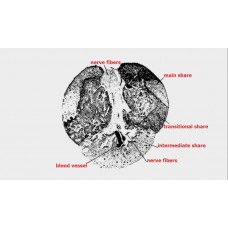The pituitary gland is an endocrine gland located at the base of the brain (lower cerebral appendage). Hormones of pituitary gland, taking part in metabolism, regulate the processes of growth and development of the organism. Gonadotropic hormone of the anterior pituitary gland stimulates ovulation of eggs in fish.
It is an unpaired, irregular oval-shaped formation originating from the lower side of the intermediate brain (hypothalamus); its shape, size, and position are extremely varied in fish of different groups. In carp, carp, and most other fish, the pituitary gland is heart-shaped and lies almost perpendicular to the brain; in the silver carp, it is elongated, slightly flattened from the sides, and lies parallel to the brain.
The pituitary gland distinguishes two main sections of different origin: the cerebral (neurohypophysis), which constitutes the internal part of the gland that develops from the lower wall of the intermediate brain (as an indentation of the bottom of the III cerebral ventricle), and the glandular (adenohypophysis), which is formed from the indentation of the upper wall of the pharynx. The adenohypophysis is divided into three parts (lobes, lobes): the main (anterior, located on the periphery), transitional (the largest), and intermediate. Adenohypophysis is the central gland of endocrine system. In the glandular parenchyma of its roles, it produces a secret that contains a number of hormones, which stimulate growth (somatic hormone is necessary for bone growth), regulate the function of the sex glands and thus affect puberty, influence the activity of pigment cells (determine the body color and especially the appearance of mating attire) and increase resistance to high temperatures in fish. Removal of the pituitary gland leads to a halt in growth and maturation.
Pituitary gland
Tags: pituitary gland

